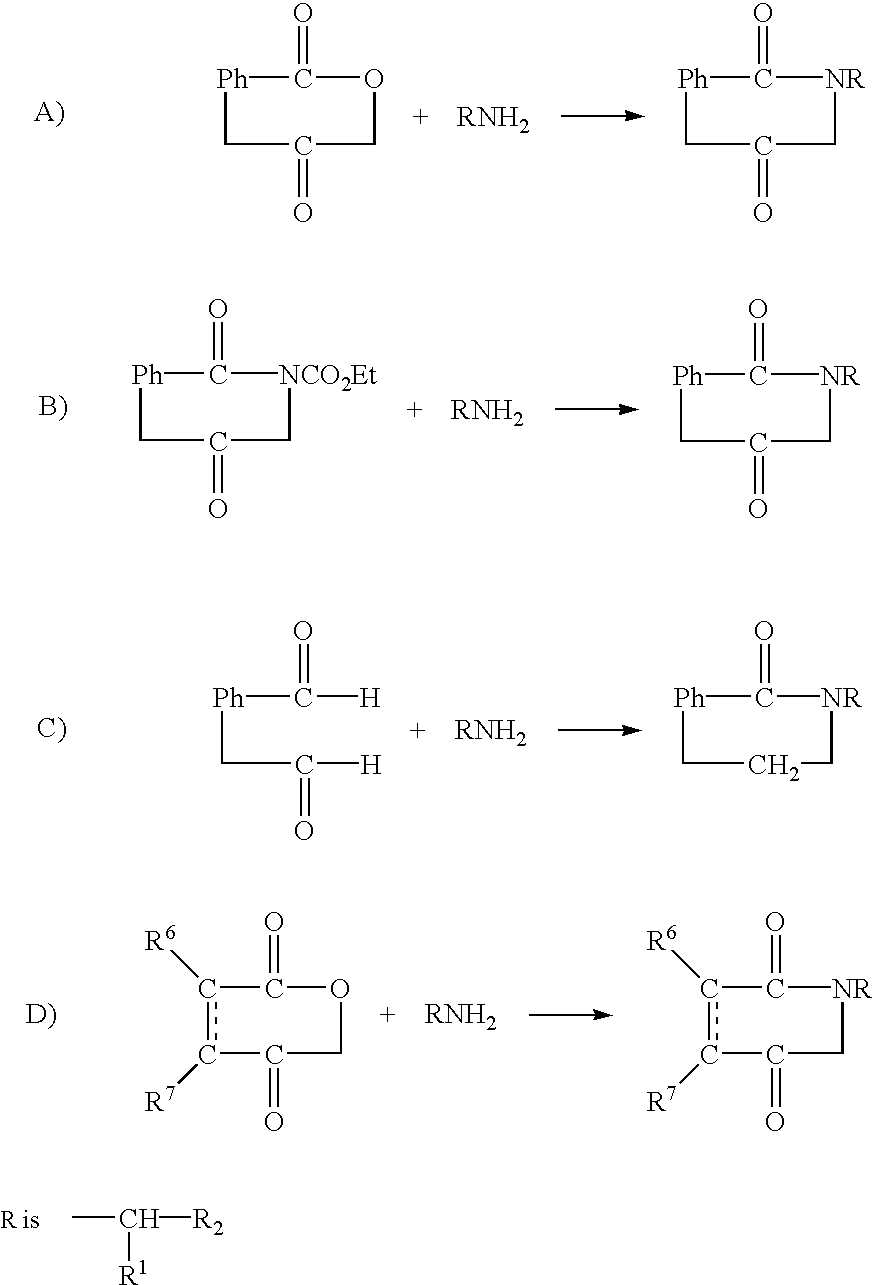Substituted imides
a technology of imides and substitutes, applied in the field of substitution imides, can solve the problems of impaired t-cell mediated immunity and severe opportunistic infections in infected individuals
- Summary
- Abstract
- Description
- Claims
- Application Information
AI Technical Summary
Benefits of technology
Problems solved by technology
Method used
Image
Examples
example 1
2-Phthalimido-3-(3,4-dimethoxyphenyl) propane. To a stirred solution of 3-(3,4-diethoxyphenyl)-2-aminopropane (1.95 grams, 10.0 mmol) and sodium carbonate (1.06 grams, 10.0 mmol) in 50 milliliters of water was added N-carbethoxyphthalimide (2.19 grams / 10.0 mmol). After 10 minutes the reaction mixture was diluted with 40 milliliters of acetonitrile and the mixture stirred for 40 minutes. The reaction solution was partially concentrated in vacuo to remove the acetonitrile. The resulting mixture of an oil and aqueous layer was extracted with methylene chloride (25 milliliters). The organic extract was dried over sodium sulfate and concentrated in vacuo to afford a crude product which was purified by flash chromatography to afford 1.73 grams (53%) of product as a thick oil which slowly solidified to a white wax: 1H NMR (dmso-d6, 250 MHz) δ 7.7 (m, 4 H, Ar), 6.7 (m, 3 H, Ar), 4.63 (m, 1 H, CH), 3.79 (s, 3 H, Ome), 3.73 (s, 3 H, OMe), 3.28 (dd, 1 H, J=13.8, 9.8 Hz) 3.03 (dd, J=13.8, 6.5 H...
example 2
1-Phthalimido-1-(3′,4′- dimethoxyphenyl) Ethane
a) 3′,4′-Dimethoxyacetophenone oxime. A solution of hydroxylamine hydrochloride (3.33 grams, 48 mmol) and sodium acetate (4.92 grams, 60 mmol) in 20 milliliters of water was added to a stirring solution of 3′,4′- dimethoxyacetophenone (5.41 grams, 30.0 mmol) in a mixture of water (30 millileters) and ethanol (30 milliliters), the solution was stirred overnight. The resulting mixture was filtered and the solid dried in vacuo (60° C., <1 mm) to afford 4.68 grams (80%) of product as a yellow solid: mp 137-138 ° C.; 1H NMR (CDCl3) δ 7.34-7.08 (m , 2H), 6.94-6.80 (m, 1H), 3.92 (s , 3H), 2.28 (s , 3H); 13C NMR (CDCl3) δ 155.6, 150.1, 148.8, 129.2, 119.2, 110.6, 108.6, 55.8.
b) 1-(3′,4′-Dimethoxyphenyl)ethylamine. 3′,4′-Dimethoxyacetophenone oxime (1 gram, 5.1 mmol) was dissolved in 10 milliliters of glacial acetic acid, the solution was flushed with N2 and the palladium on carbon (0.2 grams, 5%) was added. The mixture was treated with 60 ...
example 3
1-Phthalimido-1-(4′-methoxyphenyl)propane
a) 4′-Methoxypropiophenone oxime. A solution of hydroxylamine hydrochloride (3.33 grams, 48 mmol) and sodium acetate (4.92 grams, 60 mmol) in 20 milliliters of water was added to a stirred solution of 4-methoxypropriophenone (5.26 grams, 30.0 mmol) in a mixture of water (30 milliliters) in a mixture of water (30 milliliters), a further 20 milliliters of ethanol was added to a stirred solution of 4-methoxypropiophenone (5.26 grams, 30.0 mmol) in a mixture of water (30 milliliters) and ethanol (30 milliliters), a further 20 milliliters of ethanol was added to get a homogenous solution, which was stirred overnight. The resulting slurry was filtered, the filtrate was partially concentrated, to remove the ethanol and a white solid precipitated. The slurry was filtered and the solid was washed with water, and dried in vacuo (25° C., <1 mm) to afford 5.26 grams (98%) of product as a white solid: 1H NMR (CDCl3) δ 7.64-7.42 (m, 2H), 7.04-6.81(m, ...
PUM
| Property | Measurement | Unit |
|---|---|---|
| optical purity | aaaaa | aaaaa |
| concentration | aaaaa | aaaaa |
| bone resorption | aaaaa | aaaaa |
Abstract
Description
Claims
Application Information
 Login to View More
Login to View More - R&D
- Intellectual Property
- Life Sciences
- Materials
- Tech Scout
- Unparalleled Data Quality
- Higher Quality Content
- 60% Fewer Hallucinations
Browse by: Latest US Patents, China's latest patents, Technical Efficacy Thesaurus, Application Domain, Technology Topic, Popular Technical Reports.
© 2025 PatSnap. All rights reserved.Legal|Privacy policy|Modern Slavery Act Transparency Statement|Sitemap|About US| Contact US: help@patsnap.com



